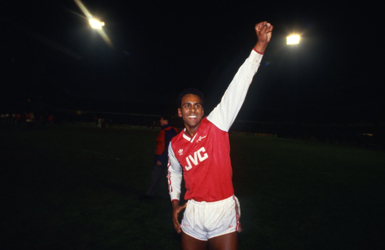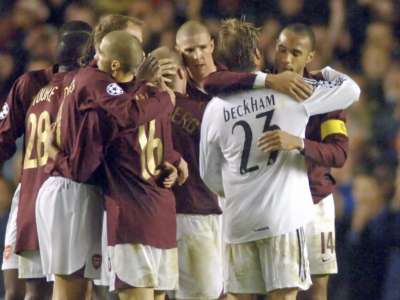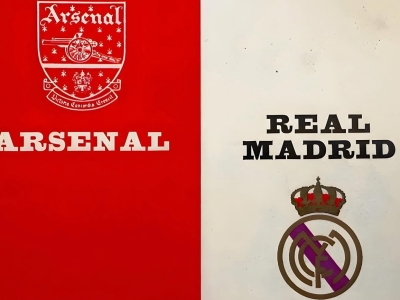Arsenal's first League Cup tie of the 1980s was a draw against a team from Wales who during the early 1980s were a team on the up. In late August 1980 there would be a trip to South Wales to face John Toshack's Swansea City, then of the old Second Division. A goal for Frank Stapleton earned Arsenal a 1-1 draw in the first leg. At Highbury in the second leg, a John Hollins penalty as well as goals for Alan Sunderland and Steve Walford earned Arsenal a 3-1 win and progressed to the third round 4-2 on aggregate. This brought a third round tie away to Stockport County. At Edgeley Park, goals for John Hollins, Frank Stapleton and Alan Sunderland earned Arsenal a 3-1 victory.
Then came a trip to White Hart Lane in early November to face Spurs in the Fourth Round. In front of a crowd of 42,511, a goal for Ossie Ardiles meant that Arsenal crashed out of the tournament. In 1981/82, the tournament was now sponsored by the Milk Marketing Board and now known as the Milk Cup. In October 1981, the Gunners were drawn against Sheffield United – the first leg away at Bramall Lane. The Gunners suffered a 0-1 defeat. In the second leg at Highbury three weeks later, goals for Alan Sunderland and Willie Young in his final appearance for the Gunners meant a 2-0 victory and progressing to the next round with a 2-1 win on aggregate. Back at Highbury a fortnight later, in front of a crowd of 19,899 a Peter Nicholas goal gave Arsenal a 1-0 victory over Norwich City.
The fourth round brought a visit to Highbury from the Cup holders Liverpool on the first day of December. Bob Paisley's side at the end of 1981 were going through something of a mini-decline and actually sat mid-table. Making his debut that night for Arsenal would be Ray Hankin, who had moved from the NASL's Vancouver Whitecaps. The two sides went on to play out a 0-0 draw. One week later at Anfield, former Gunner Ray Kennedy made his final appearance for Liverpool before transferring to Swansea City. Arsenal held out the full ninety minutes at Anfield, however extra time goals for Kenny Dalglish, Terry McDermott and Craig Johnston earned Liverpool a 3-0 victory.
Five days later, Liverpool were required to fly to Tokyo to play Brazilian side Flamengo in the World Club Championship, where they were thumped 0-3. On returning to the UK however, the Red Machine picked up form and actually won back their League title. Along the way, they also retained the League Cup by defeating Spurs 3-1 in the final. In 1982/83, Arsenal would be drawn against Cardiff City in the Second round, with the first leg at Highbury. In front of a crowd of just 15,115, goals for Paul Davis and John Hollins meant a 2-1 victory for Arsenal. The second leg tie at Ninian Park saw goals for Paul Davis, Alan Sunderland and Tony Woodcock and a 3-1 victory for the Gunners (5-1 on aggregate).
Two weeks on, the Gunners would be drawn at away to Howard Kendall's Everton in the third round. Four days prior, the Toffees would be hammered 0-5 at home to Liverpool, with four goals from Ian Rush. As a result, only 13,089 bothered to turn out for the tie. In the event, goals for two teenagers - Gary Stevens of Everton and Stewart Robson of Arsenal – meant a 1-1 draw and a replay back at Arsenal at fortnight later. At Highbury for the replay, just 19,547 would be interested in turning out for the game. Those who did were treated to an Alan Sunderland hat-trick as Arsenal ran out 3-0 winners. One week later, Arsenal played Huddersfield in the fourth round. An Alan Sunderland penalty gave Arsenal a 1-0 win in front of 17,742.
Into the new year, Arsenal met Sheffield Wednesday at Highbury in the Quarter Finals. This time the attendance rose to 30,937, who witnessed a Tony Woodcock goal, which gave Arsenal a 1-0 victory and a two legged Semi Final against Man United. One day after Valentine's Day at Highbury, Arsenal met Ron Atkinson's side for the first leg. If Arsenal were buoyed by the fact that United had failed to win at Highbury for fifteen years, it would be long before that optimism would be punctured by a returning Frank Stapleton (who lest we forget took the same route to Old Trafford taken by Robin Van Persie and Alexis Sanchez in recent seasons).
Arsenal went four goals down, with Stapleton, Northern Irish teenage prodigy Norman Whiteside and two goals for Steve Coppell. Arsenal managed to pull two goals back from Peter Nicholas and Tony Woodcock, but still suffered a 2-4 defeat. Ahead of the second leg, Stapleton would speak to Thames News about the abuse received from the Highbury terraces that night. In the second leg at Old Trafford, a then mammoth 56,635 turned out for the tie, despite the nation being gripped by the Ken Barlow and Mike Baldwin love triangle with Ken's wife Dierdre (at half time, the Old Trafford scoreboard had actually decided to give Manc pride a boost by announcing that had chosen him over brash Cockney Mike).
Goals for Kevin Moran and Steve Coppell inflicted a 1-2 defeat on Arsenal, with the Gunners' response coming from Raphael Meade, with Man United progressing to Wembley with a 6-3 win on aggregate. Man United went on to suffer defeat to a Liverpool side who captured their third successive League Cup victory. Arsenal and United met again in another Semi Final a couple of months later. The Gunners again tasted defeat to United, who went on to bag only their second trophy win since their 1968 European Cup win. It would be one of two FA Cup wins for Frank Stapleton, doubling his Highbury trophy haul, but as this footage from 90s Sitcom 'Game On' would show, he'd still be remembered primarily as a former Arsenal player.
In 1983/84, in October Arsenal would be drawn against Plymouth Argyle in the Second round of the League Cup. A Graham Rix goal at Home Park earned a 1-1 draw for Arsenal. In the second leg at Highbury, an Alan Sunderland goal meant the Gunners progressed to the next round with a 2-1 victory on aggregate. In early November, Arsenal faced Spurs at White Hart Lane in the third round. A crowd of 48,200 turned out at the Lane, where goals for Charlie Nicholas and Tony Woodcock gave Arsenal a 2-1 victory while Spurs' goal came from a Glenn Hoddle penalty. After the game, Eamon Andrews would surprise Arsenal keeper (formerly of Spurs) with his big red book for his 'This is Your Life' episode.
Jennings had been brought to Highbury by Terry Neill, whose failure to follow up the FA Cup win in 1979 with further silverware left him under fire at Highbury by the time of Walsall's visit to Highbury for the League Cup fourth round tie. Making his debut for Arsenal would be Ian Allinson, while it would be the final appearance in an Arsenal shirt for Alan Sunderland. Though Stewart Robson would be on target, Arsenal crashed to a 1-2 defeat and a repeat of the famous Cup exit to Walsall of nearly half a century prior. The result left Terry Neill's position untenable and within weeks would face the sack as Arsenal boss.
Appointed in his place would be Don Howe. Such was the turn around that by the time of Arsenal's next appearance in the League Cup they would be situated around the top of the League table. In the second round, they'd be drawn against Bristol Rovers. Goals for Viv Anderson, Tony Woodcock and two for Charlie Nicholas meant a 4-0 victory. In the second leg two weeks later, a goal from Tommy Caton meant a 1-1 draw and the Gunners progressing with a 5-1 win on aggregate. In the third round on Halloween Night, top of the old First Division Arsenal would head to the Manor Ground to face the Robert Maxwell funded Oxford United who at the time topped the old Second Division.
This would be the first ever meeting between the two sides, as Oxford United had only entered the Football League in 1962. Highlights of the game would be covered by the BBC's 'Sportsnight'. Despite goals for Ian Allinson and Graham Rix, Arsenal crashed to a 2-3 defeat, with a goal from future Liverpool star John Aldridge who ended up stretched off after scoring Oxford's opening goal. It would be Arsenal's second defeat in a week after losing to West Ham in the League the previous Saturday. After a good start to the season, Arsenal finished the season in seventh place. Twelve months on, Arsenal faced Hereford in the Second round of the League Cup.
After the post-Heysel ban, the League Cup took on added importance as just one of three trophies available to win. After being held to a 0-0 draw at Edger Street, back at Highbury, in front of just 15,789 spectators, goals for Viv Anderson and Charlie Nicholas gave Arsenal a 2-1 victory. In the third round, they would be drawn away to a Man City side newly promoted back to the top flight at Maine Road. Only 18,279 turned out to view a 2-1 win for Arsenal courtesy of goals from Ian Allinson and Charlie Nicholas. In November, Arsenal faced Southampton at Highbury in the fourth round. Despite playing top tier opposition, only 18,244 came to Highbury to view proceedings . Those who did turn out however were only rewarded with a goalless draw.
The replay at the Dell a week later however saw Arsenal progress to the Quarter Finals with Martin Hayes's first goal for Arsenal (ten days after making his Arsenal debut), as well as Charlie Nicholas and Stewart Robson on target. The following January, Arsenal were drawn against Aston Villa away. Arsenal ended 1985 with an excellent run of form that saw impressive wins over Liverpool at Highbury and a 1-0 victory over run away table toppers Man United. Villa on the other hand were mired into a relegation battle just four years on from winning the European Cup. Injury to John Lukic meant that Rhys Wilmot made his debut in goal for the Gunners at the age of twenty four (despite having been at Highbury since 1979).
Arsenal took the lead with a goal from an in form Charlie Nicholas, led by a rather mad pitch invasion from a success starved Arsenal fan base sensing some long awaited glory. In the second half, a nineteen year old Niall Quinn came close to wrapping things up for the Gunners by hitting the bar. Aston Villa however equalised with a goal from Dean Glover, set up by Andy Gray. Most thought Arsenal were a shoo in for the replay back at Highbury. The 33,091 who turned out at Highbury however witnessed a 1-2 defeat courtesy of goals from Paul Birch and Allan Evans, while Paul Mariner would be on target for Arsenal.
A further defeat in the FA Cup to Luton Town that same month saw Arsenal look to replace Don Howe with Terry Venables. After these revelations came out in the national press, Don Howe resigned as Arsenal boss on Good Friday 1986. The Gunners replaced him with George Graham in May. By 1986, the tournament was now sponsored by retailer and football pools company Littlewoods. George's first League Cup tie as Arsenal boss would be against Herbert Chapman's old side Huddersfield Town, who were lined up to sign Martin Hayes. In front of a crowd of just 15,194 at Highbury, goals for Paul Davis and Niall Quinn gave Arsenal a 2-0 victory. Two weeks later in the second leg, Martin Hayes was on target in a 1-1 draw, which saw the Gunners progress with a 3-1 win on aggregate.
Hayes's form by now had saw him retained by George Graham and a first team regular, keeping the veteran Graham Rix out of the Arsenal side. The end of October 1986 saw Arsenal drawn against Man City at home. Hayes would be on target again from the penalty spot. Goals for Paul Davis and David Rocastle meant a 3-1 win for Arsenal. The fourth round saw a visit from a Charlton Athletic side back in the top flight, but evicted from their home at the Valley and playing at Crystal Palace's Selhurst Park. A goal for Niall Quinn and a Charlton own goal meant that the Gunners progressed to the Quarter Finals on the back of a 2-0 victory. That victory earned Arsenal a home tie against Brian Clough's Nottingham Forest in late January, while the Gunners held a surprise lead at the top of the old First Division.
Goals for Charlie Nicholas and Martin Hayes earned Arsenal a 2-0 victory in front of 38,617 and a mouth watering Semi Final with Tottenham Hotspur. The first leg would be played in early February at Highbury and covered live on ITV's 'The Big Match'. Such was the standing of the League Cup then, that the Semi Final would be played on a Sunday and a postponement of the scheduled League fixture. It would be a piece of history as the first ever live competitive fixture at Highbury shown on British TV. Also on his first outing as an analyst would be a young Alan Hansen. As Ian St. John explained, the game would be a commentator's nightmare as it contained two Thomases (Michael making his debut), two Allens and a Hoddle and a Waddle.
Arsenal though would be without David Rocastle who was sent off against Man United two weeks prior and replaced with Perry Groves, as well as an injured Viv Anderson who was replaced by Gus Caesar. A Clive Allen goal however meant a 0-1 first leg defeat for Arsenal. The second leg at White Hart Lane would again be another live Sunday fixture, this time on the BBC's 'Match of the Day'. Allen in his 'annus miribulus' season where he beat Jimmy Greaves's record for most goals scored in one season for Spurs. Famously, after trialling by two goals at half time, the Spurs PA system had announced how Spurs fans could go about apply for tickets for the final, which was used by George Graham to spur his side on in the second half.
Goals from Viv Anderson and Nialll Quinn brought Arsenal level, which took the game into extra time. The BBC had scheduled a repeat of 'The Muppets' straight after the game. As it went into extra time however, the BBC's Barry Davies had announced that the episode of the Muppets would be cancelled that week (there was me thinking I'd just watched them concede a two goal lead from a position of great arrogance!). With no further scoring in extra time, the tie went to a replay. Spurs won the toss for choice of venue and so three days later it was back to White Hart Lane. This time, it wouldn't be live, but shown on ITV's 'Midweek Sports Special' back to back with Terry Marsh's World Welterweight title winning fight from a tent in Basildon.








